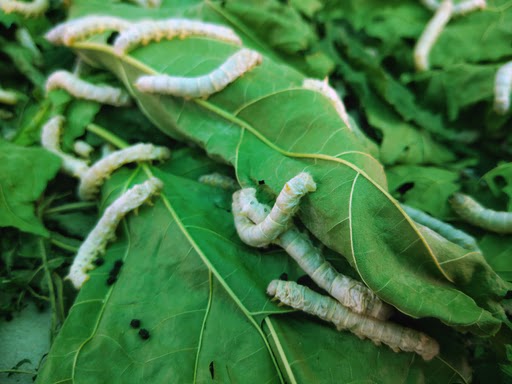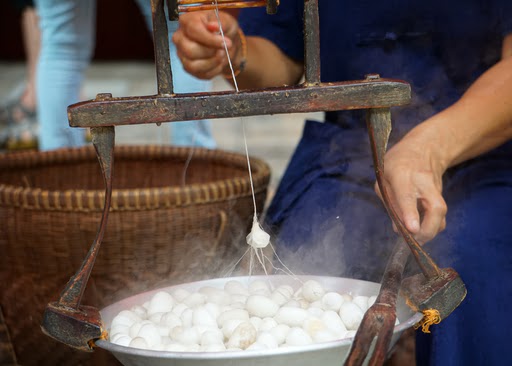Silkworm larvae enter the resting phase by creating a natural covering around themselves, which eventually hardens into a cocoon. This cocoon is the source of precious silk.
Smooth like butter, comfortable like cotton, and strong like steel. This fabric is a dream for many, and it’s none other than silk!
 Silk fabric (Photo Credit: Mara Fribus/Shutterstock)
Silk fabric (Photo Credit: Mara Fribus/Shutterstock)
If you’ve ever been to clothing markets in China or India, you’ve probably encountered silk. It has a unique texture, a soft touch, and a shiny appearance. These distinctive qualities make silk one of the most desired fabrics in the market.
But where does this fabric come from? Not from plants or mammals, but from insects!
Yes, those tiny creatures we often disregard are the creators of this luxurious material. It’s hard to believe that such a exquisite fabric comes from an insect. Fortunately, this insect is not as repulsive as a cockroach or as potentially painful as a bee. It comes from a harmless moth.
Specifically, most of the silk we see comes from a special species of moth called Bombyx Mori, which has played a significant role in this ancient process for thousands of years.
History Of Silk: Chinese Origin
Silk is one of the oldest known fabrics to mankind, and it was first discovered in ancient China. According to Chinese legend, it was discovered around 5000 years ago by Empress Xi Ling-shi, the wife of the legendary Emperor Huangdi. The folklore surrounding her discovery of silk is as fascinating as the story of Newton and gravity!
Here’s how the story goes. One day, the empress was sitting in a garden under a mulberry tree. She was drinking tea and sharpening her sword. Unbeknownst to her, a cocoon fell into her cup of hot tea. Just as she was about to take a sip, she noticed a shiny thread unraveling from the cocoon in her tea. The empress was captivated by this unusual cocoon that had fallen into her tea.
She started searching the surrounding trees and plants to find where the cocoon came from. Her search led her to discover more cocoons of silkworms (Bombyx Mori). She was amazed by the other cocoons hanging from the mulberry tree and realized that the thread was made by the silkworms inside the cocoons. The soft thread-like cocoon gave the empress a brilliant idea: to weave fabric from it!
She began studying these silkworms and recorded her observations. After thorough research, she managed to understand the life cycle of moths and how cocoons could be utilized to produce silk, the soft and smooth fabric. So, what exactly did she learn about silkworms?
The Life Cycle Of Silkworms
Well, silkworms, like other moths, undergo a beautiful life cycle, transforming from tiny insects smaller than ants into butterfly-sized winged moths. However, this transformation is not direct, and it involves several stages in their life cycle.
An adult female moth lays eggs, with silk moths laying hundreds of eggs at once. When these eggs hatch, small caterpillars, known as larvae, emerge and immediately begin searching for food. These larvae primarily feed on leaves from mulberry trees and grow exponentially larger in just a few weeks, increasing their size by nearly 10,000 times.
 Silkworms (larvae) feeding on leaves (Photo Credit : Pomme Home/Shutterstock)
Silkworms (larvae) feeding on leaves (Photo Credit : Pomme Home/Shutterstock)
Source Of Silk
Once they have finished feeding, the larvae enter a resting phase. To understand this phase, think about how humans rest or sleep. Humans simply need a comfortable cover, like a blanket, to rest. Silkworms behave in a similar manner.
During the resting phase, the larvae begin to create a natural covering around themselves. They have a special spinneret in their mouth that secretes slimy threads made of protein. By moving their heads in various directions, they create a cocoon by wrapping themselves in these threads. When exposed to air, the slimy covering hardens and forms a thick fiber coat, which is the highly sought-after silk.
 Cocoon: the source of silk (Photo Credit : HikoPhotograph y/Shutterstock)
Cocoon: the source of silk (Photo Credit : HikoPhotograph y/Shutterstock)
At this point, the larva transforms into a pupa, which remains stationary and does not move. While in the pupal stage, the pupa develops the organs that adult moths have inside the cocoon shell. After a few weeks of pupation, an adult moth emerges from the cocoon.
These moths mate, and the female moths lay eggs, starting the cycle anew.
 The lifecycle of a silkworm: From egg to moth (Photo Credit : ChilliPix/Shutterstock)
The lifecycle of a silkworm: From egg to moth (Photo Credit : ChilliPix/Shutterstock)
Some may assume that we use the cocoons to obtain silk once the adult moth leaves the cocoon shell. However, this is not the case. If we wait until the adult moth emerges, the silk will degrade and become unsuitable for fabric. Therefore, we steam the cocoons while the silkworms are still in the pupal stage. There is an entire industry dedicated to extracting silk from cocoons, known as sericulture.
What Is Sericulture?
Sericulture involves breeding and cultivating silkworms to obtain silk, and is commonly practiced in rural areas of China and India. The cultivated Bombyx Mori species typically hatch eggs during the summer and take around 3-4 weeks to hatch. Once hatched, the larvae are fed mulberry leaves five times per day.
This feeding process continues until the larvae enter the pupal stage, where they enclose themselves in a cocoon. The cocoons are then placed in a container and boiled for a few minutes to kill the pupae before they can transform into moths. While this process may seem cruel, it is necessary for silk production.
The boiling of the cocoons helps to unravel the silk threads by melting Saracen, a gelatinous protein that binds the cocoon. To harvest the silk, threads from 30-50 cocoons are combined into a single, thicker thread by passing them through a small hole in a bamboo stick onto a hand-operated reel. The operator slowly and carefully turns the reel, unraveling the threads of the cocoon.
Obtaining a pound of silk requires two to three thousand cocoons. The process of unraveling the cocoon is time-consuming and labor-intensive. This is why silk is expensive and often used in luxurious items.
 A woman is unraveling silk thread from boiled cocoons (Photo Credit: Julija Ogrodowski/Shutterstock)
A woman is unraveling silk thread from boiled cocoons (Photo Credit: Julija Ogrodowski/Shutterstock)
The next step involves washing the thread in warm water to clean it and remove any remaining Saracen remnants. The thread is then dyed to achieve the desired color. After dyeing, the silk thread is dried. Once dry, it is fed into large rollers and weavers, which produce the final silk fabric. This Vox video demonstrates the process of extracting silk from silkworms:
A Final Word
Silk is renowned for its durability, surpassing many metal wires in strength. In fact, it is the strongest natural fiber known to humans. What’s even more remarkable is that it originates from a seemingly fragile moth. This is the marvel of nature… it continually surprises us!
